white supremacy

Did you know that Oregon was founded as place for white people only?
Yes. Yes, it was.
In a complicated twisting political tale of pre-Civil War American history, enshrined in my state’s constitution were explicit and clear black exclusion laws.

For the second year in a row, every Academy nominee in an acting category is white.
Forget Idris Elba in Beasts of No Nation. Or Michael B. Jordan in Creed. Or Bernicio Del Toro in Sicario. Or Will Smith in Concussion.
The 93% White, 76% Male Academy wasn't interested.
Straight Outta' Compton was also lauded as a potential best picture nominee, but was only nominated for Best Original Screenplay, which was written by two white writers. Similarly, only Sylvester Stallone was nominated for Creed, a film with a black lead actor and a black director.

Editor’s Note: A lot has happened this year, and there has been much to cover — much to lament, much to praise, and much to record into history. It has been our privilege and honor to write, edit, and read along with you. In no particular order, here are our 15 favorite stories of 2015.

Jim Wallis is determined to bring ongoing conversations about race in America to his fellow white Christians.
“If white Christians acted more Christian than white,” he writes in his latest book America’s Original Sin: Racism, White Privilege, and the Bridge to a New America, “black parents would have less to fear for their children.”
Below, you can watch the trailer for the book, which focuses on the Edmund Pettus Bridge in Selma, Ala., where hundreds of civil rights demonstrators were attacked by armed policeman in 1965.

There has so far been no official accounting of what happened to Smith the morning of Nov. 1 on the second-floor landing of the Marbury Plaza Apartments in Southeast D.C. The Medical Examiner’s report tells part of the story, but there is still so much more unknown.
"I'm no longer stating that my son was beaten to death. My son was tortured to death. There are more injuries in the coroner’s report than I could visibly see with my eyes. There were injuries on my son’s back. He was hemorrhaging — the back. The back of his head was busted,” said mother Beverly Smith.

Banners posted at predominantly white churches across the country in support of the “Black Lives Matter” movement have been vandalized — some of them more than once.
Since the Unitarian Universalist Association passed a resolution last summer affirming the movement, 17 of more than 50 congregations that have posted signs have seen them vandalized or stolen.
The Rev. Neal Anderson, senior minister of the Unitarian Universalist Fellowship of Northern Nevada in Reno, said his largely white congregation posted its fourth sign after the third one was stolen on Halloween weekend. The first banner was vandalized in August.
“For me the vandalism was sort of this physical and visible sign of white supremacy,” he said of the first act of vandalism.
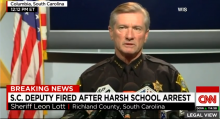
South Carolina sheriff Leon Lott announced Wednesday afternoon that Ben Fields, the police officer who violently arrested a 15-year-old black female student at Spring Valley High School, has been fired.
"It's not what I expect from my deputies, and it's not what I tolerate from my deputies," said Lott.
Although Lott removed Fields from his police force, he also commented on the behavior of the student.

On the morning of Oct. 26, a student at Spring Valley High School in South Carolina was flipped out of her desk and tossed across the room by school resource officer Ben Fields.
Fields is already facing an outstanding lawsuit filed against him for "recklessly targeting African-American students with allegations of gang membership." But in 2014, Fields received a "Culture of Excellence" award for being "an exceptional role model to the students he serves and protects."
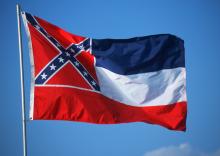
Campus police officers at the University of Mississippi removed the state flag from its campus this morning, days after resolutions from the student body, staff, and faculty urged such action, according to a press release from the University of Mississippi.
It is the first predominantly white institution of higher education in the state of Mississippi to ban the flag.
The student senate was the first to pass the resolution, after 3 hours of "respectful and impassioned debate" culminating in a 33-15-1 vote in support of removal.

Police are stepping up patrols and trying to develop a profile of whomever has set six fires outside churches in predominantly black neighborhoods since Oct. 8, Police Chief Sam Dotson said.
The American Civil Liberties Union of Missouri and the Anti-Defamation League suggested a racial motive may be at play. In a prepared statement, the ACLU of Missouri’s executive director, Jeffrey Mittman, called the fires “domestic terrorism.”
“It is a sad truth that, throughout our nation’s history, African-Americans often have been met with astounding violence when they demand equality,” he wrote.
“Those who commit this violence seek to instill fear. This is why arson against predominantly black churches has been a frequent tool of white supremacy.”

The social theory of the hegemonic male lays claim to the idea that there is a particular type of individual that our culture caters to and strives to be. When looking at the lack of gender and racial-based diversity in the U.S. film industry, I believe that this is a valid claim to make.
The hegemonic male is a white, cisgender, intelligent, handsome, and powerful man who has achieved great economic, political, and/or social status. He is the ideal and standard by which many in our culture aspire to become—for good or for ill. (Think Don Draper.)
According to this theory, everyone is in competition to be the most hegemonic male that one can be. However, it’s difficult for an individual to ever feel as though he has reached this status, as it always feels like more power is possible. Furthermore, it’s impossible for women, people of color, or members of the LGBTQ community to gain any traction in this competition as their race, ethnicity, gender, and/or sexual identification does not line up with the supposed ideal. This competition among members of our culture, while not often articulated, often leaves many individuals feeling unfulfilled. It is virtually impossible to live up to the social norms and expectations set before them.

EVEN AS SOUTHERN states—and GOP candidates—jumped through hoops to distance themselves from the Confederate flag, a backlash erupted among those claiming the flag was merely a symbol of “heritage.” Battle-flag waving Southerners (and Confederacy sympathizers) seemed to leap at the opportunity to wave their banner high.
But what about the rest of us? One of the most profound statements I’ve heard recently came from Rev. Jin Kim, founding pastor of Church of All Nations in Minnesota. This Korean-born pastor stood at the podium of the Sojourners Summit and said with conviction: “I am a white supremacist.”
How can this man, a person of color who’s dedicated his life to ethnic and cultural reconciliation, be a white supremacist? The same way any of us can. After all, at its heart white supremacy is not about white hoods, battle flags, and burning crosses. Those symbols are what we call explicit bias. People know when they are practicing it.
But most often white supremacy is about implicit bias that favors whiteness. It’s about the unconscious associations we make in our minds before we even know we’ve done it. White? Rich. Black? Poor. White? Good. Black? Bad. White? Trustworthy. Black? Scary. You get the idea.
These are the unconscious biases that shape the way we order our lives; the communities we live in, the places we shop, the churches we attend, the leadership from others we accept (or reject), and the policies we support (or don’t).
It’s not hard to fume at the thought of the killer of Mother Emanuel’s Nine. And it feels good to click “like” and share posts calling for the removal of Confederate flags.
But if we stop there, bias beats us. It is the unconscious biases of the masses that keep us from moving forward, not the explicit biases of the few. So, check out this tongue-in-cheek list of four easy ways to be a white supremacist (regardless of your own race).
1. Plan a conference on church planting with a speaker lineup so white it would make Honey Boo Boo blush. And if you want to increase your “diversity,” have one speaker of color (even if he is from India), an Asian emcee, and maybe a black worship leader.

I didn’t see the film Malcolm X in theaters. I waited to see it on video. Big mistake.
I watched it in my home, just off campus from University of Southern California, late at night when everyone else was sleeping. Another big mistake.
At the time I was living in a house with one other black person and a bunch of white and Asian friends. I was attending a mostly white school and a mostly white church and had attended a mostly white institute for urban transformation that was borne out of my church. Ironically, it was there that I was required to read The Autobiography of Malcolm X. But I never read the whole thing, only sections.
So, I sat in the dark living room, lit only by the television screen, and watched Denzel Washington bring Malcolm X to life … by myself. And there, in the dark, Malcolm’s words about Jesus hit me to the core.

For white people who care about racism, it’s time we stop pointing the finger at others and start confessing our own sin.
Every white person I know denounces the blatant, tragic racism of Dylann Roof. They abhor that this sort of thing could possibly happen in 2015. They can’t believe there still exists people who are THAT racist, who would fly the Confederate flag, who could possibly say (x and y and z). They shudder and shake at such insanity.
Many white moderates and conservatives I know would express such a view.
And some of those white people are also quick to point out “structural racism.” Chastising the “lone wolf” fallacies of those who think Roof acted outside of a racist context, these folks stress the importance of systems. For them, racism isn’t simply perpetrated by extremist Southerners or a few power-hungry police officers. Rather, it’s sustained primarily in local and national policies. With their cultivated, educated, birds-eye view, these white people expose “white privilege.” They, ahem, get it.
This is the enlightened white liberal par excellence.
But both views enable an understanding of racism that exists outside our own selves. Racism doesn’t exist outside our own selves, white folks. It doesn’t simply exist in THAT guy. It’s not just a vague political force in policy. It exists in you. It exists in me. I am racist. I am a white supremacist. And if you're white and reading this, you probably are too.
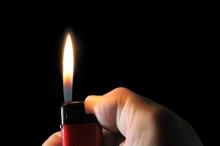
Our nation doesn't have to be this way. Churches do not have to be burning. Innocent lives do not have to be lost. Together, we can bring an end to this dark night and step into the light of justice and peace. But it will take a lot more than blog posts and prayer vigils. It's going to take those of us with privilege changing the way we live our lives; changing the way we teach our children; changing the way we interact in the world.
This is hard work, but it's work that must be done if we are to see an end to this violence and injustice in our nation. It begins with a choice to see and live in our world differently, starting today.

White people can no longer afford to deny the violent racism that infects our lives. Rather, we must take responsibility for it. The first thing we need to do is to name it. Yes, name it in people like the terrorist who killed the nine people at Emmanuel last Wednesday. Name it in our political, economic, and entertainment systems that propagate and benefit from racist structures. For example, did you know that currently, “the U.S. has a greater wealth gap between whites and blacks than South Africa did during apartheid?” Name it for the sinful, demonic structure that it is.
But just as important, name the racism that infects you. It’s not helpful to just name racism in others if we don’t also take responsibility for the racism within each of us. Name it in yourself so that you can repent from it. And once you repent from it, name it again and again. Racism is so embedded in our culture that its evil will surely return to our lives.
PARDEEP KALEKA and former white supremacist Arno Michaelis clasped hands during a radio interview on the first anniversary of a mass shooting that changed both of their lives. Their embrace was the ultimate symbol of brotherhood—two starkly different backgrounds united by a common goal of peace and understanding in an oftentimes cruel and unforgiving world.
Pardeep Kaleka is a member of the Sikh faith community. His father was one of the six worshippers killed on Aug. 5, 2012, at the Sikh temple, or gurdwara, in Oak Creek, Wis. Three more were injured that day before the man opening fire on the temple was wounded by the police. The gunman then prepared for one final pull of the trigger, taking his own life.
The shooter was Wade Michael Page, a white supremacist, acting on his own volition that Sunday morning. He had spent his life practicing violence and hatred toward all kinds of people he felt to be “different” from him. This hatred culminated in a final unthinkable act, killing six people in cold blood at their holy place of worship.
There was angst, confusion, and grief among the Wisconsin Sikh community after this terrible tragedy. But where many may have expected anger from those most deeply affected, the Sikhs responded with something thoroughly refreshing: peace.
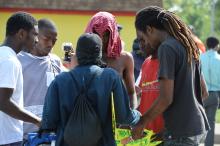
If, as many of the religions of the world affirm, there is a profound equality of dignity and worth between all human beings by virtue of their humanity alone, then what are we to make of a nation and its citizens who allow an entire group of people, a people once brutally enslaved and still actively oppressed, to continue to be stigmatized in ways that implicitly affirm their inferiority as a group and so allow too many of them to experience the devastating consequences of entrenched racial inequality? That nation and its citizens would stand accused of the greatest of injustices. That nation and its citizens would have a divine duty to end that injustice. The United States and we its citizens stand so accused today. Until we understand the imperative to eliminate racial inequality as an obligation grounded in ultimate reality, we will fail to understand the magnitude of our responsibility.
Whether the issue is wealth, health, incarceration, employment, or education, blacks as a group experience significantly disproportionate negative outcomes compared to whites. What accounts for this difference? Only two options are available. Significant racial inequality over time is explained either by forces external to the lives of black individuals (e.g., economic, legal, and social forces), or by the aggregate consequences of choices made by these individuals. Unless one concludes that racial inequality is entirely explained by forces external to the lives of black people, one is forced to conclude that there is something inferior about blacks as a group that causes them persistently to make more bad life choices than whites as a group.
At this point, some will object that some black people do indeed make bad choices that lead to bad outcomes. But so do some white people. The question is what accounts for the differences in the proportion of bad outcomes?

THE METRO IS crowded today, and the 20-something, well-dressed white man has to stand, one hand holding the bar and the other his smartphone. It’s the end of the day. All the commuters—but one—are turned toward home. The young man’s face, like most of the others, is dulled with exhaustion. No one makes eye contact.
In a seat near the door, one woman sits facing everyone, looking backward. She studies the young man’s face intently, uncomfortably. He shifts. She rearranges the bags at her feet. Her reflection in the window shows an ashy neck above her oversized T-shirt collar. The train hums and clicks through a tunnel. As if in preparation, she takes another sip from the beat-up plastic cup she’s holding.
At last, she raises her voice and asks: “Why are white people so mean?” Boom! The electricity of America’s third rail crackles through the train. Faces fold in like origami or turn blank like a screensaver.
But this was no rhetorical question. When no one answers, she asks again, this time aiming her question at the young man with his phone. A flush creeps up his neck. “You look like you could be a sheriff,” she says to him. “Good and mean. I can see it in your eyes. You got mean eyes.” When he realizes her attention is stuck on him, he replies, “I hope I’m not mean. I try to be good.”
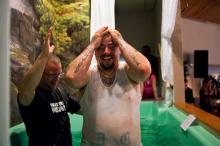
Two years ago, Chris Simpson led a white pride march.
Six months ago, he abandoned the white supremacy movement.
On April 15, he was baptized.
Five days later, Simpson sat in the waiting room of a skin and vein clinic, waiting to start the long and painful process of having his tattoos, most replete with Nazi or white pride iconography, removed.
"Hate will blind you to so many things. It will stop you from having so many things," Simpson said. "It consumes you."